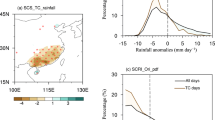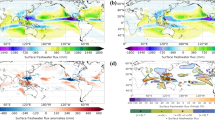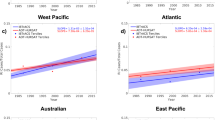Abstract
The impact of climate change on tropical cyclones (TCs) is of great concern in the Western North Pacific (WNP) region. Observations suggest that there have been recent changes in TC-related heavy rainfall. However, it has not yet been determined whether anthropogenic forcing has any contribution to such changes. Here, we show evidence that the human-induced warming has considerably changed the frequency of TC-induced heavy rainfall events in the WNP region. Observations since 1961 show that the occurrence of TC-induced heavy rainfall has significantly increased along coastal East Asia, while it has decreased in the southern part of WNP. On the basis of large ensemble climate simulations, we demonstrate that the observed changes cannot be explained solely by natural variability. This suggests that anthropogenic impacts have already significantly altered the TC-induced heavy rainfall pattern in the WNP region.
This is a preview of subscription content, access via your institution
Access options
Access Nature and 54 other Nature Portfolio journals
Get Nature+, our best-value online-access subscription
$29.99 / 30 days
cancel any time
Subscribe to this journal
Receive 12 print issues and online access
$209.00 per year
only $17.42 per issue
Buy this article
- Purchase on Springer Link
- Instant access to full article PDF
Prices may be subject to local taxes which are calculated during checkout




Similar content being viewed by others
Data availability
All datasets used in this study are publicly available: d4PDF climate simulation dataset is available at http://search.diasjp.net/en/dataset/d4PDF_GCM; IBTrACS best track dataset is available at https://www.ncdc.noaa.gov/ibtracs/; APHRODITE precipitation dataset is available at http://aphrodite.st.hirosaki-u.ac.jp/.
Code availability
The code used for the TC detection in this study is available at a GitHub repository: https://github.com/nbykutsumi/wsd_d4pdf_ncc. More information about the code can be obtained from the corresponding author upon request.
References
IPCC Climate Change 2021: The Physical Science Basis (eds Masson-Delmotte, V. et al.) (Cambridge Univ. Press, 2021).
Weinkle, J. et al. Normalized hurricane damage in the continental United States 1900–2017. Nat. Sustain. 1, 808–813 (2018).
Utsumi, N., Kim, H., Kanae, S. & Oki, T. Relative contributions of weather systems to mean and extreme global precipitation. J. Geophys. Res. Atmos. 122, 152–167 (2017).
Trenberth, K. E., Dai, A., Rasmussen, R. M. & Parsons, D. B. The changing character of precipitation. Bull. Am. Meteorol. Soc. 84, 1205–1217 (2003).
Knutson, T. R. et al. Global projections of intense tropical cyclone activity for the late twenty-first century from dynamical downscaling of CMIP5/RCP4.5 scenarios. J. Clim. 28, 7203–7224 (2015).
Liu, M., Vecchi, G. A., Smith, J. A. & Knutson, T. R. Causes of large projected increases in hurricane precipitation rates with global warming. npj Clim. Atmos. Sci. 2, 38 (2019).
Mori, M. et al. Hindcast prediction and near-future projection of tropical cyclone activity over the Western North Pacific using CMIP5 near-term experiments with MIROC. J. Meteorol. Soc. Jpn. II 91, 431–452 (2013).
Yoshida, K., Sugi, M., Mizuta, R., Murakami, H. & Ishii, M. Future changes in tropical cyclone activity in high-resolution large-ensemble simulations. Geophys. Res. Lett. 44, 9910–9917 (2017).
Sugi, M., Murakami, H. & Yoshida, K. Projection of future changes in the frequency of intense tropical cyclones. Clim. Dynam. 49, 619–632 (2017).
Cha, E. J., Knutson, T. R., Lee, T.-C., Ying, M. & Nakaegawa, T. Third assessment on impacts of climate change on tropical cyclones in the Typhoon Committee Region—Part II: Future projections. Trop. Cyclone Res. Rev. 9, 75–86 (2020).
Kossin, J. P., Emanuel, K. A. & Camargo, S. J. Past and projected changes in Western North Pacific tropical cyclone exposure. J. Clim. 29, 5725–5739 (2016).
Wang, C. & Wu, L. Influence of future tropical cyclone track changes on their basin-wide intensity over the western North Pacific: downscaled CMIP5 projections. Adv. Atmos. Sci. 32, 613–623 (2015).
Nguyen-Thi, H. A., Matsumoto, J., Ngo-Duc, T. & Endo, N. Long-term trends in tropical cyclone rainfall in Vietnam. J. Agrofor. Env. 6, 89–92 (2012).
Ying, M., Chen, B. & Wu, G. Climate trends in tropical cyclone-induced wind and precipitation over mainland China. Geophys. Res. Lett. https://doi.org/10.1029/2010GL045729 (2011).
Zhang, J., Wu, L., Ren, F. & Cui, X. Changes in tropical cyclone rainfall in China. J. Meteorol. Soc. Jpn. II 91, 585–595 (2013).
Chang, C.-P., Lei, Y., Sui, C.-H., Lin, X. & Ren, F. Tropical cyclone and extreme rainfall trends in East Asian summer monsoon since mid-20th century. Geophys. Res. Lett. 39, L18702 (2012).
Tu, J.-Y. & Chou, C. Changes in precipitation frequency and intensity in the vicinity of Taiwan: typhoon versus non-typhoon events. Environ. Res. Lett. 8, 014023 (2013).
Kim, J.-H., Ho, C.-H., Lee, M.-H., Jeong, J.-H. & Chen, D. Large increase in heavy rainfall associated with tropical cyclone landfalls in Korea after the late 1970s. Geophys. Res. Lett. https://doi.org/10.1029/2006GL027430 (2006).
Guzman, O. & Jiang, H. Global increase in tropical cyclone rain rate. Nat. Commun. 12, 5344 (2021).
Lau, W. K. M. & Zhou, Y. P. Observed recent trends in tropical cyclone rainfall over the North Atlantic and the North Pacific. J. Geophys. Res. Atmos. 117, D03104 (2012).
Pham-Thanh, H., Ngo-Duc, T., Matsumoto, J., Phan-Van, T. & Vo-Van, H. Rainfall trends in Vietnam and their associations with tropical cyclones during 1979–2019. SOLA 16, 169–174 (2020).
Lee, T.-C., Knutson, T. R., Nakaegawa, T., Ying, M. & Cha, E. J. Third assessment on impacts of climate change on tropical cyclones in the Typhoon Committee Region—Part I: Observed changes, detection and attribution. Trop. Cyclone Res. Rev. 9, 1–22 (2020).
Murakami, H. et al. Detected climatic change in global distribution of tropical cyclones. Proc. Natl Acad. Sci. USA 117, 10706–10714 (2020).
Kay, J. E. et al. The Community Earth System Model (CESM) large ensemble project: a community resource for studying climate change in the presence of internal climate variability. Bull. Am. Meteorol. Soc. 96, 1333–1349 (2015).
Mizuta, R. et al. Over 5,000 years of ensemble future climate simulations by 60-km global and 20-km regional atmospheric models. Bull. Am. Meteorol. Soc. 98, 1383–1398 (2017).
Ishii, M. & Mori, N. d4PDF: large-ensemble and high-resolution climate simulations for global warming risk assessment. Prog. Earth Planet. Sci. 7, 58 (2020).
Mitchell, D. et al. Half a degree additional warming, prognosis and projected impacts (HAPPI): background and experimental design. Geosci. Model Dev. 10, 571–583 (2017).
Yatagai, A. et al. APHRODITE: constructing a long-term daily gridded precipitation dataset for Asia based on a dense network of rain gauges. Bull. Am. Meteorol. Soc. 93, 1401–1415 (2012).
Knapp, K. R., Kruk, M. C., Levinson, D. H., Diamond, H. J. & Neumann, C. J. The international best track archive for climate stewardship (IBTrACS): unifying tropical cyclone data. Bull. Am. Meteorol. Soc. 91, 363–376 (2010).
Park, D.-S. R., Ho, C.-H. & Kim, J.-H. Growing threat of intense tropical cyclones to East Asia over the period 1977–2010. Environ. Res. Lett. 9, 014008 (2014).
Lai, Y. et al. Greater flood risks in response to slowdown of tropical cyclones over the coast of China. Proc. Natl Acad. Sci. USA 117, 14751–14755 (2020).
Kossin, J. P. A global slowdown of tropical-cyclone translation speed. Nature 558, 104–107 (2018).
Yamaguchi, M. & Maeda, S. Slowdown of typhoon translation speeds in mid-latitudes in September influenced by the Pacific Decadal Oscillation and global warming. J. Meteorol. Soc. Jpn. II 98, 1321–1334 (2020).
Moon, I.-J., Kim, S.-H. & Chan, J. C. L. Climate change and tropical cyclone trend. Nature 570, E3–E5 (2019).
Lanzante, J. R. Uncertainties in tropical-cyclone translation speed. Nature 570, E6–E15 (2019).
Yamaguchi, M., Chan, J. C. L., Moon, I.-J., Yoshida, K. & Mizuta, R. Global warming changes tropical cyclone translation speed. Nat. Commun. 11, 47 (2020).
Utsumi, N., Seto, S., Kanae, S., Maeda, E. E. & Oki, T. Does higher surface temperature intensify extreme precipitation? Geophys. Res. Lett. 38, L16708 (2011).
Ogata, T., Mizuta, R., Adachi, Y., Murakami, H. & Ose, T. Effect of air–sea coupling on the frequency distribution of intense tropical cyclones over the northwestern Pacific. Geophys. Res. Lett. 42, 10415–10421 (2015).
Eyring, V. et al. Overview of the Coupled Model Intercomparison Project Phase 6 (CMIP6) experimental design and organization. Geosci. Model Dev. 9, 1937–1958 (2016).
Mizuta, R. et al. Climate simulations using MRI-AGCM3.2 with 20-km grid. J. Meteorol. Soc. Jpn. II 90A, 233–258 (2012).
Utsumi, N., Kim, H., Kanae, S. & Oki, T. Which weather systems are projected to cause future changes in mean and extreme precipitation in CMIP5 simulations?. J. Geophys. Res. Atmos. 121, 10522–10537 (2016).
Yokoyama, C. & Takayabu, Y. N. A statistical study on rain characteristics of tropical cyclones using TRMM satellite data. Mon. Weather Rev. 136, 3848–3862 (2008).
Prat, O. P. & Nelson, B. R. On the link between tropical cyclones and daily rainfall extremes derived from global satellite observations. J. Clim. 29, 6127–6135 (2016).
Hasselmann, K. Optimal fingerprints for the detection of time-dependent climate change. J. Clim. 6, 1957–1971 (1993).
Hegerl, G. C. et al. Detecting greenhouse-gas-induced climate change with an optimal fingerprint method. J. Clim. 9, 2281–2306 (1996).
Santer, B. D. et al. Contributions of anthropogenic and natural forcing to recent tropopause height changes. Science 301, 479–483 (2003).
Acknowledgements
N.U. was supported by MEXT/JSPS KAKENHI grant nos. 21H01442, 21H05178 and 18KK0117, and Japan Science and Technology Agency (JST) as part of the Belmont Forum. H.K. was supported by the National Research Foundation of Korea (NRF) grant funded by the Korean Government (MSIT; grant no. NRF-2018R1A5A7025409 and 2021H1D3A2A03097768) and the Integrated Research Program for Advancing Climate Models by MEXT, Japan (JPMXD0717935457).
Author information
Authors and Affiliations
Contributions
N.U. and H.K. conceived the idea of the study. N.U. performed the analysis. N.U. and H.K. interpreted the results and developed the manuscript.
Corresponding authors
Ethics declarations
Competing interests
The authors declare no competing interests.
Peer review
Peer review information
Nature Climate Change thanks the anonymous reviewers for their contribution to the peer review of this work.
Additional information
Publisher’s note Springer Nature remains neutral with regard to jurisdictional claims in published maps and institutional affiliations.
Supplementary information
Supplementary Information
Supplementary Figs. 1–10 and associated texts.
Rights and permissions
About this article
Cite this article
Utsumi, N., Kim, H. Observed influence of anthropogenic climate change on tropical cyclone heavy rainfall. Nat. Clim. Chang. 12, 436–440 (2022). https://doi.org/10.1038/s41558-022-01344-2
Received:
Accepted:
Published:
Issue Date:
DOI: https://doi.org/10.1038/s41558-022-01344-2
This article is cited by
-
Locally opposite responses of the 2023 Beijing–Tianjin–Hebei extreme rainfall event to global anthropogenic warming
npj Climate and Atmospheric Science (2024)
-
Influence of typhoons on the spatiotemporal variation in rainfall erosivity in the Pearl River Basin
Theoretical and Applied Climatology (2024)
-
Tropical cyclones over the South China Sea suppress the monsoonal rainfall in southern China
npj Climate and Atmospheric Science (2023)



